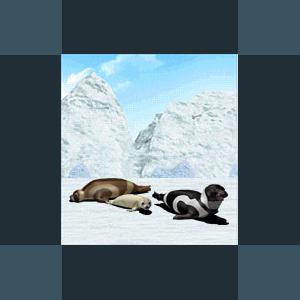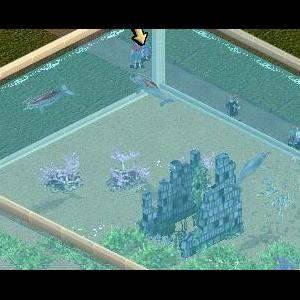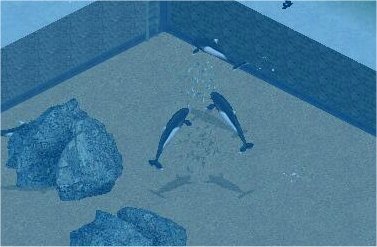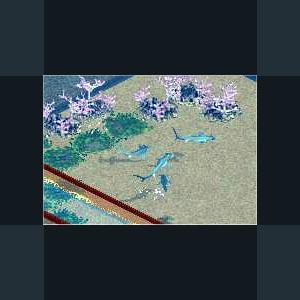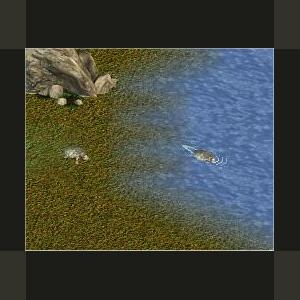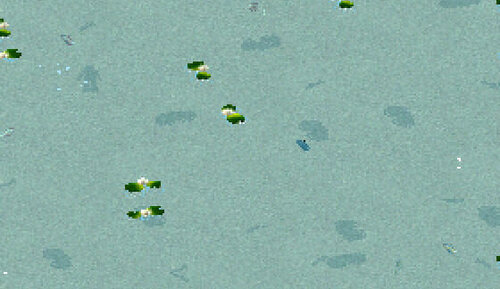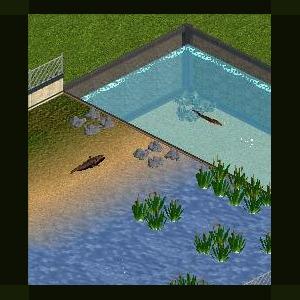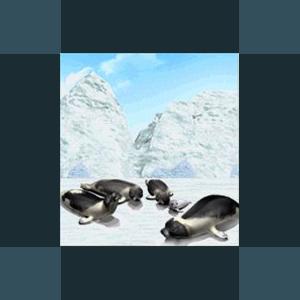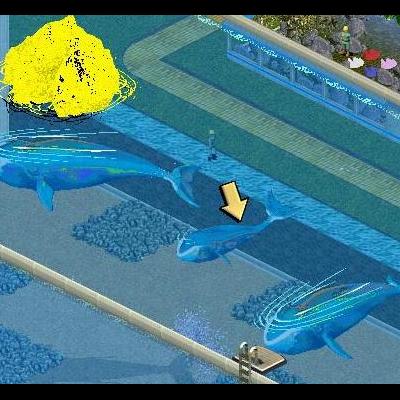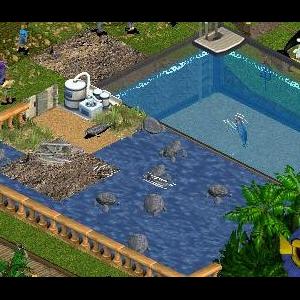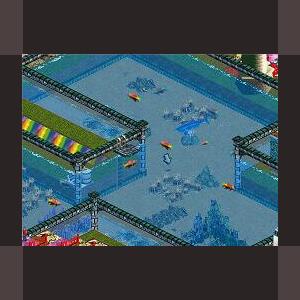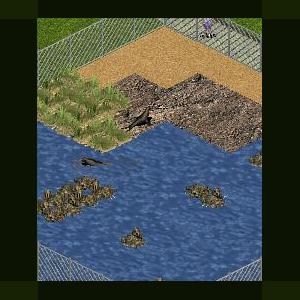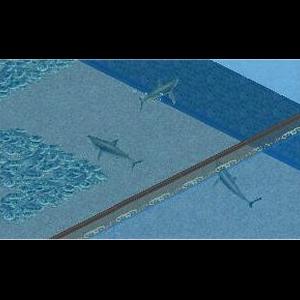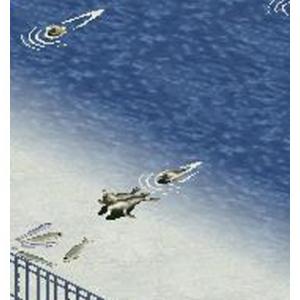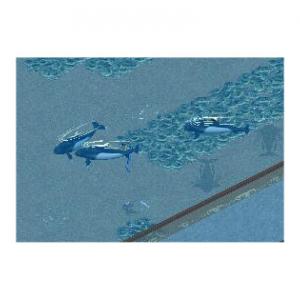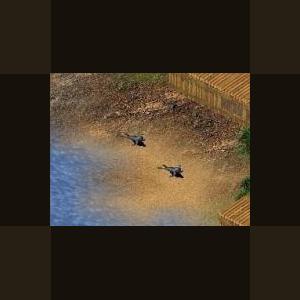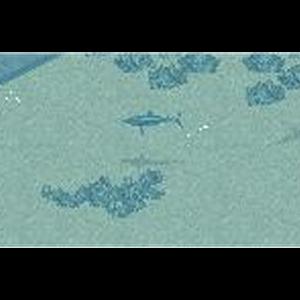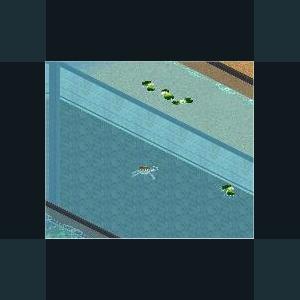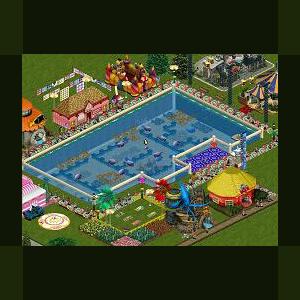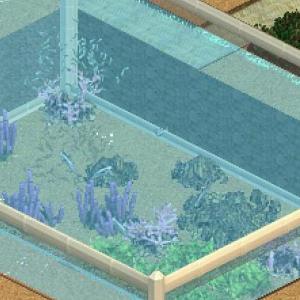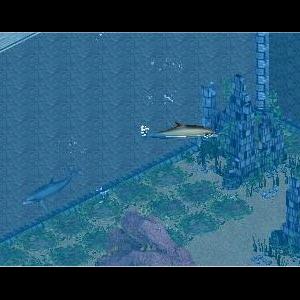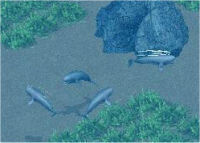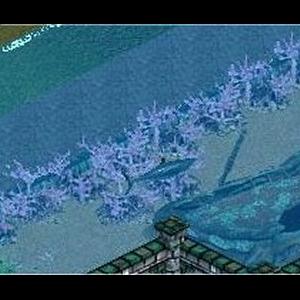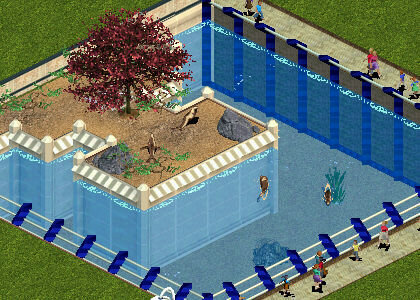Marine
Creatures under the sea
47 files
-
Ribbon Seal by Tasmanian Tiger
By Guest
The ribbon seal of the north pole to add to your zoo!
The ribbon seal is compatible with the emperor penguin, although the emperor penguin doesn't like it, it will accept its presence and cause no problems.
Updated: September 27, 2013 by Jay to remove the background for the male animal list icon, to add animal list icons for the female and young, to remove the top and bottom edges of the purchase menu icons, to adjust the positions of all animations, to make minor adjustments to the animal info, to add the preferred object tooltip for the female and young, to add the capability of a simple surface roll trick for show tanks, to add the capability to use 3 user made toys, to add a purchase menu tooltip, to remove unnecessary files and configuration lines, and to correct configuration mistakes done by the APE program. Please note that the version at Taz's site is no longer the most current version, since she is deceased.
Current ztd date: September 27, 2013
Compatibility : All Game Versions
Description : The ribbon seal or the Histriophoca fasciata grows to a maximum of 1.9 metres in size. It is found in the Arctic and Subarctic regions of the North Pacific Ocean, notably in the Bering Sea and Sea of Okhotsk. It is the only species in the genus Histriophoca. The Ribbon Seal is a medium-sized pinniped from the family called Phocidae. Members of the Phocidae family are also called true seals or earless seals because they lack external ear flaps. Since newborn ribbon seals do not enter the water for a number of weeks, the young of this ribbon seal does not go in water. This Ribbon Seal can use the Ice Floe For Certain Animals By Taz, the Ice Floe For Certain Animals, and the Raft For Certain Animals. The Ribbon Seal is compatible with the Emperor Penguin, although the Emperor Penguin doesn't like it but will accept its presence and cause no problems. However, if the Emperor Penguin is in the same exhibit, then the exhibit must not have the Ice Floe For Certain Animals By Taz, the Ice Floe For Certain Animals, or the Raft For Certain Animals, since the penguin could get stuck on those toys, being that the penguin is not configured for those toys. The Ribbon Seal is also compatible with the Harp Seal made by Taz.
Note: ZT is not used to animals where the adults go in tanks while the young do not. So it can keep changing its mind between the exhibit being suitable and the exhibit needing more salt water terrain and less snow. Whenever it does change its mind and wants more salt water terrain, do so. Eventually it will get to a point where it does not change its mind.
1,204 downloads
Updated
-
Baiji by Tasmanian_tiger
By Tasmanian_tiger
The baiji is a freshwater dolphin found only in the Yangtze River in China. The dolphin is also called Chinese River Dolphin, Yangtze River Dolphin, Whitefin Dolphin and Yangtze Dolphin. The Baiji population declined drastically in decades as China industrialized and made heavy use of the river for fishing, transportation, and hydroelectricity. Efforts were made to conserve the species, but a late 2006 expedition failed to find any Baiji in the river. Organizers declared the Baiji "functionally extinct",[4] which would make it the first aquatic mammal species to become extinct since the demise of the Japanese Sea Lion and the Caribbean Monk Seal in the 1950s.
I hope you enjoy this addition to your zoos. Combine the baiji with pandas to create lively 'river-tanks'.
Updated: July 10, 2013 by Jay to correct 3 animation views, to remove unnecessary files and configuration lines, and to make some minor adjustments to the animal info.
The update dated Jul 28 2013 is not an update. It is because I moved the file from Animals to Marine.
839 downloads
Updated
-
Dall's Porpoise by Ghirin
By Guest
Dall’s porpoise (Phocoenoides dalli), also known as the white-flanked porpoise, is a robust porpoise with a striking black and white piebald pattern. It is reported to be a fast cetacean (reaching speeds up to 55 km/hr for short periods) and regularly rides the bow waves of ships when the vessel is moving at a minimum of 26 km/hr. Dall’s porpoises are also known for sending up “rooster-tail” water sprays when they surface.
Dall’s porpoises are native to the northern Pacific Ocean and range from Japan to California. Unlike several other porpoise species, Dall’s porpoise is regularly reported in open oceanic waters. It often forms groups of two to twelve individuals, but these small schools have been known to merge into groups of several thousand.
Their diet consists mainly of squid, fish, and krill.
*Inspired by the Zoo Tycoon Brains Trust at the Zoo Tek Forums.
References:
Walker’s Mammals of the World. Nowak, 1999.
Animal: The Definitive Visual Guide the World’s Wildlife. Burnie and Wilson, 2001.
http://www.bbc.co.uk/nature/wildfacts/factfiles/128.shtml
Updated August 18, 2018 by Cricket so that screenshot would show up again.
Created by Ghirin 2004
363 downloads
0 comments
Updated
-
Bonnethead Shark by Ghirin
By Guest
The bonnethead shark (Sphyrna tiburo) is one of the the smallest members of the hammerhead shark family. These small sharks prefer tropical and subtropical coastal regions where there is continental shelf and are exclusive to the western hemisphere. Bonnethead sharks migrate to warmer waters during the winter months.
Bonnethead sharks are easy to distinguish from other hammerheads by the shape of their heads, which is more shovel-shaped than other hammerhead species. Their diet consists of crustaceans such as blue crabs and shrimp, mollusks, and small fishes. Females tend to consume more food, possibly to provide energy for reproduction.
This species of shark usually forms schools of up to fifteen individuals and they use their cerebrospinal fluid for communication between individuals. During birthing season (these sharks are livebearers), females predominate in shallow waters.
*Inspired by the Zoo Tycoon Brains Trust at the Zoo Tek Forums.
References:
-Hessing, S. 2000. "Sphyrna tiburo" (On-line), Animal Diversity Web. http://animaldiversi...rna_tiburo.html.
-Bester, C. "Bonnethead" (On-line), Florida Museum of Natural History.
http://www.flmnh.ufl...Bonnethead.html
Created by Ghirin 2004
699 downloads
Updated
-
Western Pond Turtle by Ghirin
By Guest
Western Pond Turtle
Author: Ghirin
The western pond turtle is native to the Pacific Northwest of North America. Its preferred habitat is near streams, rivers and slow-moving bodies of water. The diet includes insects, small fish, and frogs.
Created by Ghirin 2005
548 downloads
Updated
-
Trout Pack by Coolperson5
By Guest
A pack of freshwater trout.
This pack includes 5 species of freshwater trout.
Apache Trout
Bull Trout
Cutthroat Trout
Gila Trout
Golden Trout
Each fish needs a 5 square tank of any depth with 2 squares of water lilys and one square of rocks. The zookeeper will say that it needs a mate if it is alone, but it will not affect suitability or happiness.
Have Fun!
This file includes both Trout Pack_CP5Combined.ZTD, which is combined, and the 5 individual files. If the combined .ZTD is used, the others are not needed.
580 downloads
0 comments
Updated
-
0 comments
Submitted
-
Harp Seal by Tasmanian_tiger
By Fern
Author : Taz (Tasmanian_tiger)
Category : Real animal, Pinniped
Updated: September 25, 2013 by Jay to remove the background for the male and female animal list icons, to add an animal list icon for the young, to remove the top and bottom edges of the purchase menu icons, to adjust the positions of all animations, to make minor adjustments to the animal info, to add the preferred object tooltip for the female and young, to add the capability of a simple surface roll trick for show tanks, to add the capability to use 3 user made toys, to remove unnecessary files and configuration lines, and to correct configuration mistakes done by the APE program.
Current ztd date: September 25, 2013
Compatibility : All Game Versions
Description : The Harp Seal is somewhat larger than the Common Seal, growing to 5.5 ft (1.67 m) long and with a weight of 115-180 kg (253-400 lb). Males are distinctly larger than females. Harp Seals are well known for the saddle-like spot on their backs. Adult males are creamy white overall, with a dark chocolate brown head and a broad dark chocolate brown U-shaped pattern on their back, running across the shoulders and down each flank to near the base of the tail; the pattern is often slightly asymmetrical and irregular, with dark brown spots extending onto the white parts. Adult females have a similar but less distinct pattern, with the brown being paler and greyer. Immature Harp Seals up to two to three years old are pale grey, variably spotted with darker grey. The flippers are white or pale grey, with five stout claws on each fore flipper. The tail is short, 10-15 cm long. The fur on adults is 2 cm long, dense, stiff, and velvety; the skin is roughly the same color as the fur: whitish-grey under the white fur, and dark brown under the brown fur. The vibrissae are numerous on the muzzle, the longest about 12 cm long. The newborn pups are all white except for a black nose and eyes, which helps them blend in with the snow. Puberty is reached at 5-7 years, and the maximum lifespan is more than 30 years. Since newborn harp seals do not enter the water for a number of weeks, the young of this harp seal does not go in water. This Harp Seal can use the Ice Floe For Certain Animals By Taz, the Ice Floe For Certain Animals, and the Raft For Certain Animals. The Harp Seal is compatible with the Emperor Penguin, although the Emperor Penguin doesn't like it but will accept its presence and cause no problems. However, if the Emperor Penguin is in the same exhibit, then the exhibit must not have the Ice Floe For Certain Animals By Taz, the Ice Floe For Certain Animals, or the Raft For Certain Animals, since the penguin could get stuck on those toys, being that the penguin is not configured for those toys. The Harp Seal is also compatible with the Ribbon Seal made by Taz.
Note: ZT is not used to animals where the adults go in tanks while the young do not. So it can keep changing its mind between the exhibit being suitable and the exhibit needing more salt water terrain and less snow. Whenever it does change its mind and wants more salt water terrain, do so. Eventually it will get to a point where it does not change its mind.
515 downloads
0 comments
Submitted
-
Blue Whale by JohnT
By Admin Uploader
Thank you for downloading the Blue Whale. Blue Whales are the largest known whale in the world. Blue Whales like a variety of foliage in their exhibits.
Thank you to Fern, Jay and Dr. Rick for their invaluable encouragement, guidance and expertise; and to Caddie and Pukkie for their testing expertise.
263 downloads
Updated
-
Habour (or Common) Seal by Tasmanian Tiger
By Fern
Harbour (or Common) Seal
Author : Taz (Tasmanian_tiger)
Category : Real animal, Pinniped
Updated: June 29, 2013 by Jay to correct 3 animation views, to remove unnecessary files and configuration lines, and to correct configuration mistakes done by the APE program, primarily related to animal behaviors and to sounds. Please note that the version at Taz's site is no longer the most current version, since she is deceased.
Current ztd date: June 29, 2013
Compatibility : All Game Versions
Description : The most widespread pinniped, the Common or Harbour Seal has a plump body and a small, cat-like head with a slight forehead and nostrils that form a V-shaped pattern. Its coat ranges from light to dark grey or brown, and has spots, rings and blotches all over. The breeding season varies regionally, and the pups are able to crawl and swim almost within an hour of birth. There are at least five subspecies of Common Seal. One of them, the Ungava Seal, lives in fresh water in N. Quebec, Canada. (Text by Dorling Kindersley Handbooks.)
478 downloads
0 comments
Updated
-
Cuban Hog Fish by JT (JohnRN1)
By Cricket
Thank you for downloading the Cuban Hog Fish. This colorful saltwater fish was made for the 2012 Tek Anniversary. Congratulations Tek.
"Move the .ztd file into the dlupdate (and not dupdate) folder if one exists in your Zoo Tycoon folder; otherwise move the .ztd file into the Updates folder that is in the Zoo Tycoon folder."
The default is C:\Program Files\Microsoft Games\Zoo Tycoon
Thank you to Fern and Jay for their invaluable encouragement, guidance and expertise.
--JohnT--
359 downloads
0 comments
Updated
-
Galapogos Sea Lion by Jordan MK
By Guest
Genus: Zalophus
Species: californianus wollebaeki
Identification:
There are three subspecies of Zalophus californianus. The California sea lion (Z. c. californianus) is found from southern Mexico up to British Columbia and breeds almost entirely on islands in southern California, western Baja California and the Gulf of California. The Galápagos sea lion (Z. c. wollebaeki) is found on the Galápagos Islands and also occasionally in coastal Ecuador and Colombia. The Japanese sea lion (Z. c. japonicus) is now believed to be extinct but was formerly found in the Sea of Japan. Some scientists believe that these three subspecies should in fact be classed as separate species, namely Z. californianus, Z. wollebaeki, and Z. japonicus.
Population:
There is no up-to-date count of Galápagos sea lions, the last reported population estimate of 30,000 being made in the late 1970s.
Endangerment Status:
The Galápagos sea lion is listed as Vulnerable on the IUCN Red List. This subspecies was not subjected to the same commercial exploitation that caused the depletion of California sea lion populations, although occasional sea lions were killed for their skins or to provide tooth necklaces for tourists. Many Galápagos sea lions have been and are still being killed as a result of illegal and local fishing activities around the islands, despite the Ecuador government expanding the no-fishing zone around the islands from 15 to 40 nautical miles in early 1998. The entanglement of sea lions in fishing gear, particularly in long-line hooks and nylon line, is one of the most important problems currently affecting the subspecies. Entanglement in marine debris is an additional problem. Between 1995 and November 2000 a total of 111 reports of entangled sea lions were received.
El Nino:
Galápagos sea lions are badly affected by the lack of food availability and weather conditions produced by El Niño events. During the 1982-83 El Niño all Galápagos sea lion pups born in 1982 died, while only a third of the normal number of pups were born in 1983. During the 1997-98 El Niño, the Galápagos sea lion population showed a significant decline in almost all of its colonies, a 48% population decrease caused by both mortality and migration having been observed during this period. The most affected age range were pups born between June 1997 and December 1998, suffering a 90% mortality rate. The large male sea lions, especially the dominant sea lions during the 1998 breeding season, experienced a 67% mortality rate. During the El Niño event it was found that the sea lions tried to make up for the lack in prey by feeding on lantern fish (Myctophidae) rather than the usual sardines (Clupeidae), and exhibited behavioural changes such as foraging during the night. The mortality rates indicate however that this modification in foraging behaviour was not enough to protect the population from the effects of the event. A recovery in the Galápagos sea lion population has been observed during 1999 and 2000, with an estimated 10% increase in the population. Pups born during the 1999-2000 breeding season were observed to be in good condition.
Reproduction:
Pups are born and breeding takes place on the sandy and rocky beaches of the Galápagos Islands from May - January, the timing varying from island to island. About 4-7 days after her pup is born, the mother leaves to feed at sea, thus beginning a cycle of feeding during the day, mainly at depths of 20-60m, and returning most nights to feed her pup. The pup can be nursed for as little as 6 months, but is often nursed for a year until the next pup is born. Some mothers have been known to nurse both their new pup and old pup for periods of up to a year. It is also occasionally known for mothers to nurse a single pup for up to 3 years, as long as they do not give birth to a new pup during this period. Galápagos sea lions do not migrate, remaining around the islands all year and feeding at shallow depths, mainly for sardines.
Created by JordanMK
331 downloads
Updated
-
Bronze Whale by Ghirin
By Guest
The bronze whaler (Carcharhinus brachyurus) is found in open seas as well as coastal areas and reefs. It is thought to feed on fish, small sharks and cephalopods.
Female bronze whalers give birth to 13-20 live young which can then live independently.
*Inspired by the Zoo Tycoon Brains Trust at the Zoo Tek Forums.
Reference:
Sharks, Ferrari and Ferrari. 2002.
Ghirin 2005
400 downloads
0 comments
Updated
-
Harp Seal by Ghirin
By Guest
The harp seal (Phoco groenlandica) is native to the north Atlantic ocean, ranging from the Gulf of St. Lawrence to Greenland. The fur of the seals changes with the age of the seal. The coat of the pup is white, turning gray after a few weeks. The adult coat has a background color of silvery gray with dark markings on the head and a dark band running up each flank and over the back that resembles a horseshoe or a harp.
The harp seal spends most of its time in the open sea or on ice. In the spring, the harp seals haul out on the sea ice for moulting, birthing pups, and breeding. Large numbers of seals may come together during this time.
Harp seals feed on fish and crustacenas. They bite breathing holes into the ice so that they have access to fresh air between dives for food.
References:
http://www.pagophilus.org/harpseals.htm
http://www.bbc.co.uk/nature/wildfacts/factfiles/166.shtml
Walker's mammals of the World, Nowak, 1999
Photograph:
http://www.pagophilus.org/birth.htm
Created by Ghirin 2003
394 downloads
0 comments
Updated
-
Hawaiian Monk Seal by Ghirin
By Guest
Hawaiian monk seals (Monochus schauinslandi) are found in the outer islands of the Hawaiian chain. Their genus, Monachus, is the only seal genus found in the tropics.
412 downloads
0 comments
Updated
-
Commersons Dolphin by Ghirin
By Guest
Commerson’s dolphin (Cephalorhynchus commersonii), also known as the piebald dolphin, is native to coastal waters of the southwestern Atlantic Ocean. (A second population has been identified in the Indian Ocean.) This dolphin is easy to recognize due to its striking black and white skin pattern. Young are born grey and become two-toned with age.
Commerson’s dolphins prefer coastal waters where the continental shelf is wide and flat. Their diet consists of squid, crustaceans, and fish. They usually travel in small groups of two to four animals, but large schools have been reported.
*Inspired by the Zoo Tycoon Brains Trust at the Zoo Tek Forums.
References:
Walker’s Mammals of the World. Nowak, 1999.
Animal: The Definitive Visual Guide the World’s Wildlife. Burnie and Wilson, 2001.
http://www.bbc.co.uk/nature/wildfacts/factfiles/79.shtml
Created by Ghirin 2004
413 downloads
0 comments
Updated
-
Caspian Seal by Ghirin
By Guest
The Caspian seal (Pusa caspica) is one of the smallest true seals in the world. It is native to the brackish waters of the Caspian Sea.
The Caspian seal is thought to be derived from the ringed seal of the Arctic and is close relative of the Siberian nerpa.
References:
http://en.wikipedia.org/wiki/Caspian_Seal
http://www.caspianenvironment.org/biodb/eng/mammals/Phoca%20(Pusa)%20caspica/main.htm
Created by Ghirin 2008
445 downloads
0 comments
Updated
-
Fresh Water Bull Shark by Ghirin
By Guest
The bull shark (Carcharhinus leucas) is a large, robust shark found in shallow coastal marine waters worldwide. These sharks will also enter and live in estuaries, freshwater lakes and rivers.
Bull sharks eat both bony fishes and small sharks. In the cooler portions of their range, bull sharks mate during the summer months; however, in the warmer parts of their range they may breed year-round. Females nourish the young internally for 10 to 11 months and give birth to free-swimming pups.
*Inspired by the Zoo Tycoon Brains Trust at the Zoo Tek Forums.
Reference:
http://www.flmnh.ufl.edu/fish/Gallery/Descript/bullshark/bullshark.htm
Created by Ghirin 2004
476 downloads
0 comments
Updated
-
Pig-Nosed Turtle by Ghirin
By Guest
The pig-nosed turtle (Carettochelys insculpta), also known as the Fly River turtle, is a unique species of freshwater turtle native to northern Australia and southern New Guinea. The turtle gets its name from the way its nostrils are located in the front of its snout.
Even though the pig-nosed turtle is a freshwater turtle, it resembles a sea-going turtle because it has flippers instead of front legs. These turtles have been found in a variety of habitats, including rivers, estuaries, lagoons, lakes, swamps and water pools. The waterway bottoms are usually covered with gravel and the banks are usually heavily forested.
Pig-nosed turtles are omnivorous, but have a preference for fruit and leaves.
References:
http://www.tortoise.org/archives/pignose.html
http://www.whozoo.org/Intro2002/RacheLoftin/RNL_flyriverturtle.html
http://www.chelonia.org/carettochelys_gallery.htm
Created Ghirin 2005
452 downloads
0 comments
Updated
-
Powder Blue Tang by JT (JohnRN1)
By Cricket
Thank you for downloading the Powder Blue Tang. This saltwater fish is compatible with the Cuban Hogfish and is created for the Tek 2012 Anniversary.
"Move the .ztd file into the dlupdate (and not dupdate) folder if one exists in your Zoo Tycoon folder; otherwise move the .ztd file into the Updates folder that is in the Zoo Tycoon folder."
The default is C:\Program Files\Microsoft Games\Zoo Tycoon
Thank you to Fern and Jay for their invaluable encouragement, guidance and expertise.
--JohnT--
325 downloads
Updated
-
Silver Carp by Ryno
By Guest
The silver carp (Hypophthalmichthys molitrix) is a species of freshwater cyprinid fish
349 downloads
0 comments
Updated
-
Spinner Dolphin by LAwebTek
By Guest
Spinner Dolphin
Author: LAwebTek
Classified Stenella longirostris in 1828 - the specific name referring to this species' long snout. This species is found in tropical and subtropical waters worldwide. There are no subspecies, but there are four distinct Eastern Pacific forms: the Eastern, the Whitebelly, the Costa Rican and the Hawaiian.
The Spinner Dolphin is a slender creature with a long, thin beak to which the distinct forehead slopes gently. The dorsal varies with both age and geographical form; it can lean forward, be curved, or be completely triangular in shape. The flippers are long and pointed, and a stripe links them to the eyes. Eastern Pacific and Costa Rican animals are mainly grey, with other forms usually two- or three-tone. Both the Hawaiian and Whitebelly forms have a dark grey or black dorsal cape, paler flanks and sides, and a creamy-white belly. All forms measure between 1.3 and 2.1m in length, and weigh between 45-75kg.
Units range from a few animals to a few thousand, often mixing with other cetacean species such as Pilot Whales and Spotted Dolphins. They are dramatically acrobatic, with somersaults, high spinning leaps and other aerial movements popular. They vocalise with whistles and clicks, and can travel as fast as 20kph. Spinner Dolphins inhabit both offshore and inshore waters and feed on midwater fish and squid. They are different from other dolphins in that they feeds at night.
Spinner Dolphins are often targeted in the purse-seine and yellowfin tuna fisheries of the eastern Pacific Ocean. Elsewhere, many of these dolphins are accidentally killed in gillnets, and also taken in harpoon fisheries. Some individuals have been kept successfully in captivity for at least 10 years.
2003 LAwebTek
427 downloads
Updated
-
Finless Porpoise by Ghirin
By Guest
Finless Porpoise Author: Ghirin
The finless porpoise (Neophocaena phocaenoides) is found in the costal waters from the Persian Gulf to Japan. Populations are also found in adjacent estuaries, rivers, and shallow channels. They prefer shallow waters (up to 50 m deep) with soft or sandy bottoms.
Due to its lack of a dorsal fine, it is easy to identify in the wild. The living animal is often blue-gray and may darken after death. The neck vertebrae are not fused, allowing the animal to turn its head. Males may grow to 2 m and females range up to 1.5 m in length.
Finless porpoises often seen in singly or in groups of 2-4. Large groupings of up to 20 have been reported. Their primary diet consists of small fish, squid, crustaceans, and octopus.
Created by Ghirin 2003
413 downloads
0 comments
Updated
-
Galapogos Shark by Ghirin
By Guest
The Galapagos shark (Carcharhinus galapagensis) is a common resident in the coastal waters of many tropical islands. This shark prefers shallow waters but has been known to swim in the deep water between islands. They are usually found near coral reefs.
Galapagos sharks feed on bottom-dwelling fishes such as flatfish and triggerfish. It is a viviparous species with litter sizes ranging from 6 to 16 pups. The young sharks form “nurseries” in shallow water to avoid predation by larger sharks.
This shark is known for its display when it feels threatened. The back is arched, the head is raised, and the pectoral and tail fins are lowered. The shark then swims in a twisting, rolling motion.
*Inspired by the Zoo Tycoon Brains Trust at the Zoo Tek Forums.
References:
http://www.shark.ch/cgi-bin/Sharks/spec_conv.pl?E+Carcharhinus.galapagensis
http://www.flmnh.ufl.edu/fish/Gallery/Descript/GalapagosShark/Galapagosshark.html
Created by Ghirin 2004
393 downloads
0 comments
Updated
-
Japanese Sea Lion by Coolperson5
By Guest
Japanese Sea Lion (Zalophus japonicus) is thought to have become extinct in the 1950s.
Prior to 2003 it was considered to be a subspecies of California Sea Lion as Zalophus californianus japonicus. However, it was subsequently reclassified as a separate species. Some taxonomists still consider it as a subspecies of the California Sea Lion. It has been argued that japonicus, californianus, and wollenbaeki are distinct species because of their distant habitation areas and behavioral differences.
They inhabited the Sea of Japan, especially around the coastal areas of the Japanese Archipelago and the Korean Peninsula. They generally bred on sandy beaches which were open and flat, but sometimes in rocky areas.
Currently, several stuffed specimens can be found in Japan and the National Museum of Natural History, Leiden, the Netherlands brought by Philipp Franz von Siebold. The British Museum possesses a pelt and 4 skull specimens.
426 downloads
0 comments
Updated

